Master Sergeant Mark Zulawski, U.S. Marine Corps (Retired) – I Gave It My All
Some people expect instant success in life without first laying the necessary groundwork. However, success is often an iterative process, as we try new paths and approaches, all the time refining our skills. Master Sergeant Mark Zulawski, U.S. Marine Corps (Retired), spent ten of his almost twenty-one years in the Marine Corps learning the warfare, personal, and leadership skills necessary to make him a successful recruiter and senior enlisted leader. During the course of his career, he deployed twice, helped develop the Marine’s mechanized infantry capability, and most of all, recruited countless new Marines into the Corps. This is his story.
Mark was born in Buffalo, New York, in September 1957 but his family later moved to what was then farmland in the town of Cheektowaga, now an inner-ring suburb of Buffalo. His father was a Korean War Army veteran and a butcher by trade. His mother was primarily a stay-at-home mom for Mark and his older sister and younger brother, although she did work part-time in the deli section of a nearby Save-on-Meats grocery store.
Mark attended West Seneca East Senior High School in West Seneca, New York. He played football all four years, starting as a fullback on the varsity team beginning with the second half of the first game during his sophomore year and continuing until he graduated. In recognition of his leadership on and off the field, he was named captain during his senior year. He also tried playing baseball, but his role was limited to designated runner because his speed allowed him to steal bases and score. Where his speed really mattered was on the varsity track team, where he ran the 220-yard dash and anchored the 880-yard relay team. He was the fastest runner on the team in both races, despite being unable to practice with the team because once he turned sixteen, he worked in the meat section of the same Save-on-Meats grocery store where his mother worked. Instead, he ran on his own after work and on weekends but asked his boss for time off to run in the meets.
As with all high school seniors, Mark had to decide what he wanted to do after graduation. He initially planned on attending and playing football for Upper Iowa University. However, when he visited the university, the football coach said he was not eligible for a scholarship during his freshman year and would have to prove his worth to the team before being considered.
About this same time, a Marine Corps recruiter called and asked if Mark had received the information he had sent him. Mark said he had and that he was interested in speaking with him. The recruiter followed up and they met at the recruiter’s office. Mark told him about his Upper Iowa University visit, including a part about having a few beers while there and getting sick afterwards. The recruiter leveled with Mark and said he would have a tough time making it in college because he didn’t have self-discipline. He promised if Mark joined the Marines, he would develop the self-discipline he needed.

That was the message Mark needed to hear and he decided to enlist in the Marines in April 1976, two months before graduation. He enlisted in the Delayed Entry Program, which permitted him to choose a start date after he graduated from high school. To formalize the arrangement, Mark reported to the Buffalo Military Entrance Processing Station (MEPS). There, after signing the enlistment paperwork, he passed an initial physical and took the oath of enlistment. He then finished the school year at West Seneca East High School, graduating in June 1976.
Mark returned to the Buffalo MEPS in September 1976 when it came time for him to report for active duty. After passing another physical to make sure he was still fit for duty, he and the other Marine recruits reporting with him took a flight from Buffalo to South Carolina, enroute to the Marine Corps Recruit Depot at Parris Island for boot camp. Once Mark arrived, he and the other new recruits marched to a Quonset hut to begin in-processing. This included getting yet another physical, receiving his uniforms, getting a haircut, and being assigned to Platoon 296. The drill instructors also introduced themselves to the new recruits, making it clear the first words out of their mouths for the next twelve weeks were to be “Yes, sir,” and “No, sir”. But the real fun did not begin until they completed two days of in-processing. Then, “all hell broke loose.”
Perhaps because he knew boot camp was what he needed and because he had prepared beforehand by running and lifting weights, Mark liked boot camp. It paralleled football practice in many ways, requiring him to do his best in every drill from the moment he woke up until the time he closed his eyes at night to sleep. And no matter how good his best was, the drill instructors demanded more.
One place where the strict boot camp rules were relaxed ever so slightly was the chow hall. There the recruits could chat quietly with the recruit sitting directly across from them, but no one else. Taking advantage of this, Mark always sat across from his best friend, Frank Labordie, so they could catch up during their meals. One day, they made the mistake of continuing their conversation as they were returning their food trays to the dishwashing area and one of the drill instructors, Staff Sergeant Lambert, heard them. After berating them both, he told them to remind him of their offense later so he could deal with it appropriately, promising to “bend and thrust them to death.”
Believing Staff Sergeant Lambert would forget, Mark and his friend said nothing about the infraction and laid low. The approach seemed to work until they were preparing for a footlocker inspection by the platoon gunnery sergeant (“Gunny”). All of a sudden, they were summoned to the quarterdeck ASAP. Both men ran as fast as they could to the quarterdeck, but when they arrived, they were told they had not come fast enough and to go back and do it again. This repeated itself several times until Staff Sergeant Lambert was satisfied. Mark and Frank then had to face each other and say they hated each other, and were told when they saw each other, to run away. Finally, they had to do bend and thrusts until they were exhausted.
With their infraction paid for, Mark and Frank returned for the footlocker inspection. Mark knew he was doomed because the morning events had left him insufficient time to prepare. When the Gunny reached Mark’s footlocker, Mark was still dripping sweat from his runs to and from the quarterdeck and the bend and thrusts. The Gunny looked at Mark’s footlocker and, finding it not up to Marine Corps standards, dumped the upper tray onto the floor. At this point, Mark’s only thought was “what the hell have I gotten myself into.”
Mark soon got over the event and excelled at boot camp. He also really admired Staff Sergeant Lambert, who he believed was doing his best to make them all outstanding Marines. Mark also believed Staff Sergeant Lambert picked on the recruits he liked to help drive them to their full potential, so he didn’t mind Staff Sergeant Lambert’s attention even though it might be unpleasant at times. Other recruits had more difficulty adjusting to the training, with a couple dropping out and a couple more even trying to escape Parris Island.
One aspect of boot camp Mark particularly excelled at was the physical conditioning, which helped him get into the best shape of his life. For the physical fitness test (PFT), he did 80 sit-ups in under 2 minutes, 20 dead-hang pullups, and ran 3 miles in 18:20, scoring 298 out of a possible 300 points (a perfect score required running the 3-mile course in 18:00 or under). He would achieve this score on the PFT every time he took it for the rest of his career.
After the initial “breakdown” phase of bootcamp, the training shifted to the rifle range for two weeks. By the end of rifle range phase, Mark and his fellow recruits could put an M16 round through a six-inch circle at both 200 and 300 yards. At 500 yards, they could consistently hit a target the size of a milk can. Once the recruits completed their weapons training, they moved on to the final phase of boot camp, where they were given some privileges like being able to grow their hair a little on top and blouse their trousers. Although these privileges were small, they helped Mark and the other recruits see the light at the end of the boot camp tunnel.
Graduation finally came on December 21, 1976, and Mark was officially designated a Marine. He had done exceptionally well, always giving 110% at everything he did. His drill instructors recognized this, making him a squad leader while he was there. Frank Labordie had also done well, being named the platoon’s honor graduate. All that was behind them now, though, as they prepared to head to their first assignment.
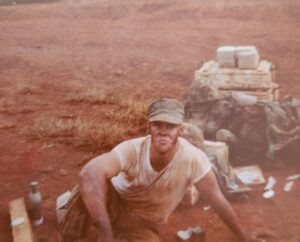
Mark’s initial assignment was with the 1st Battalion, 8th Marines (1/8 Marines), located at Camp Geiger, a satellite facility of the Marine Corps Base Camp LeJeune complex in North Carolina. Before he reported for duty, he had ten days leave to spend with his family in Buffalo. His father, who was not pleased when Mark announced he was enlisting in the Marines, beamed when Mark showed up all spit-and-polished in his Marine Corps uniform. So did his high school sweetheart, Doreen Czajka, whom he had known since fifth grade and been dating since his freshman year. After the leave passed by much too quickly, Mark said his goodbyes and departed for Camp Geiger toward the end of January.
Now a private first class (E-2), Mark checked in with the 1/8 Marines as they were preparing to deploy. This meant nonstop training, including a series of forced marches, each one longer than the one before. Mark excelled at all these activities and was selected as the Marine of the Month for March 1977. By April, the battalion had progressed from ten-mile marches to a twenty-five-mile march during the course of a single day. After the twenty-five-mile march, Mark’s Company Gunny asked him if he’d like to go to Hawaii. The only issue was the orders would have a short turnaround time, so he would have to depart soon. That sounded like an opportunity Mark couldn’t refuse, so he agreed to transfer to Hawaii.
Mark arrived in Hawaii in June 1977 and reported to his new command, the 1st Battalion, 3rd Marines (1/3 Marines), located at Marine Corps Air Station (MCAS) Kaneohe Bay on Oahu. Although a mortarman by training, he was assigned to the Headquarters and Services (H&S) Company, which provided administrative and logistical support for the other companies in the battalion. He also promoted to lance corporal (E-3) as a result of his previous selection as Marine of the Month at the 1/8 Marines at Camp Geiger.
Just as had been the case with the 1/8 Marines, the 1/3 Marines were preparing for an upcoming deployment as a Battalion Landing Team (BLT). This meant the battalion would deploy aboard Navy ships to be ready to go ashore in response to contingencies anywhere in the western Pacific (WestPac) in support of U.S. interests. Should no contingencies arise, the battalion would train with U.S. partners and allies in the region.
As the time for the March 1978 deployment neared, Mark learned no one could take leave in the thirty days leading up to the deployment. This was a problem because he and Doreen had already scheduled their wedding for February 18, 1978, and all the arrangements had been made. Mark went to his company Gunny and explained the situation. The Gunny went to bat for him and he was permitted to return to Buffalo for his wedding and to spend time with his new bride. He then rejoined his battalion in time for its deployment.
Mark and the rest of the H&S Company and their equipment loaded aboard the USS Cleveland (LPD-7) on March 25-27 at Pearl Harbor. Together with the USS San Bernadino (LST-1189), Cleveland set off for WestPac on April 1 after conducting some local operations. About ten days later, the two ships rendezvoused with the USS Tripoli (LPH-10) in the vicinity of Wake Island. Mark’s company and other elements of the BLT then cross-decked over to the USS Tripoli and continued their deployment aboard that ship. The Tripoli subsequently anchored in Subic Bay, allowing Mark some liberty time ashore. It then departed Subic Bay on May 6 for a port visit in Singapore, after which it returned to the Philippines, where the BLT spent the next several months at the Upper MAU (Marine Amphibious Unit) Camp training in the jungle environment around Subic Bay.
Prior to the deployment, Mark had been moved to the H&S Company armory, where he was responsible for checking weapons in and out, making sure they were cleaned, and addressing any weapons needing repair. He performed this function during the deployment, too, because the Marines in the company spent time at sea taking care of their weapons and used them while ashore during training and exercises. When at sea, Mark and his fellow Marines also spent time in the classroom, studying unit tactics and catching up on other required training.
The BLT leadership team took notice of Mark’s strong performance during the deployment and summoned him and other high achieving Lance Corporals to a meritorious promotion board. One at a time, Mark and the others had to appear before a board consisting of the Battalion Executive Officer (a major), company commanders (captains), and first sergeants (E-8s). They asked them questions about Marine Corps general orders, their military occupational specialty (MOS), and various other subjects. They obviously liked Mark’s answers because they meritoriously promoted him to Corporal (E-4).
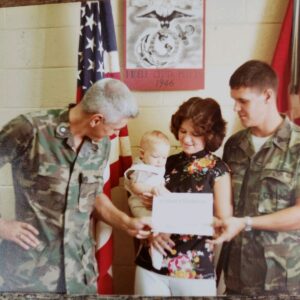
When it came time to leave the Philippines, Mark and his company boarded the USS New Orleans (LPH-11) for the return trip to Hawaii. The New Orleans arrived in Pearl Harbor at the end of September 1978, bringing Mark’s deployment to an end. His first order of business upon return was to find and furnish an apartment so Doreen could join him, which she did after about a month. They lived in Kailua on Oahu’s east coast, not far from MCAS Kaneohe Bay. They stayed there for about nine months until they progressed to the top of the wait list for base housing and then moved on base for the rest of their tour. Living on base was especially convenient because it was expensive to live out in town, the on-base commissary and exchange made shopping easy, and Doreen was able to get a job with a branch of the Bank of Hawaii located right on base.
Soon after Mark and Doreen moved on base, it came time for Mark to deploy again. This time was particularly difficult because Doreen was pregnant, making it hard to say goodbye. Even worse, due to several unexpected delays, Mark said goodbye only to return in a day or so and then had to say goodbye again when the cause of the delays was rectified. This time, Mark’s company deployed on the USS Duluth (LPD-6), which departed Pearl Harbor in early August 1979.
Mark got to see much more of WestPac on this cruise, with the Duluth making stops for port calls or exercises in Okinawa (Japan), Subic Bay (Philippines), Sydney (Australia), New Caledonia, Fiji, and Hong Kong. The most memorable event during the deployment occurred in Philippines, when Mark was playing rugby as a member of the battalion rugby team. The team had arranged for a game against a team of New Zealanders, and they were practicing in advance of the game on a helicopter landing zone on a hill because it offered a large level area. At one point, the rugby ball sailed into the trees adjacent to the field and Mark ran in after it. What he did not realize was just inside the trees was a cliff and he ran right over the edge, plummeting down through the trees thirty to forty feet before hitting the ground. He woke up in the back of a Gamma Goat (an off-road semi-amphibious vehicle) on his way to the hospital. Once there, the battalion commander visited him to see how he was doing. Miraculously, his only injuries were some sore ribs and he was otherwise okay.
Just as he had done during his first deployment, Mark excelled in all his duties and the battalion’s leadership took notice. Again he appeared before a promotion board and was meritoriously selected for sergeant (E-5). He was then moved to the battalion’s armory to supervise three qualified armorers because he had the experience and leadership skills the battalion was looking for, even if he didn’t have the small arms repairer/technician MOS.
The deployment was tough for Mark because he wanted to communicate with Doreen to hear how she was doing. At the time, however, the only ways to communicate were by letter, which took a long time, or telephone, which was very expensive. Occasionally, he could make a call via AUTOVAN, which was a military phone system that would allow him to speak with a base operator in Hawaii, who could then patch him through to his wife. Because AUTOVON calls could cut off at any time, Mark always began his calls with “I love you” and “Goodbye”. He and Doreen would then talk for as long as the connection would allow. Most of the time, though, he had to save up his money to make a call at a place in the Philippines that charged a flat rate of twenty dollars for a call.
As the deployment wound down, Doreen’s due date drew near. Rather than require Mark to sail back on the ship, the BLT designated him as part of the advance team to return to MCAS Kaneohe Bay two weeks early to prepare for the BLT’s return. Mark then flew back from the Philippines, arriving a day and a half before Doreen gave birth to their first son, Mark Jr. He also got to spend more time with his new family because now that he had deployed twice within a single tour, he was considered no longer deployable. Accordingly, he was shifted to the 2nd Battalion, 3rd Marines (2/3 Marines), where he began to train on the new M224 60mm mortar.
Mark didn’t spend much time with the 2/3 Marines because by the end of 1980, it was time to reenlist and transfer to a new duty station. In return for reenlisting, he was given orders for Inspector and Instructor (I&I) duty with the 3rd Battalion, 25th Marines (3/25 Marines) in Buffalo at the Marine Corps Reserve Center. The 3/25 Marines was a Reserve battalion, so its members drilled one weekend each month and two weeks out of every year. Mark, however, was part of a cadre of active duty Marines assigned to the unit who worked full time, providing training and administrative and logistical support to the Reserve unit.
Mark, Doreen, and Mark Jr. departed Hawaii on January 1, 1981, and checked in with India Company of the 3/25 Marines in February. Mark’s primary responsibilities were in the armory preparing the company for embarkation when it came time to deploy, but he also assisted with administrative work and reenlisting prior service Marines into the unit.
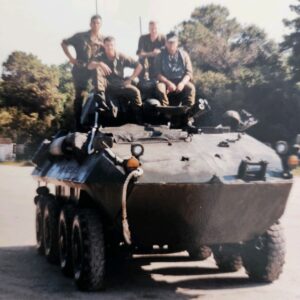
Overall, Mark enjoyed I&I duty. The active duty staff typically worked Monday through Thursday and took a half-day off on Fridays as compensation for having to work all weekend during drill weekends. They also had a competitive bowling league on Thursday, which helped keep morale and camaraderie high. The tour was, however, marred by a personal tragedy. Mark and Doreen lost their second baby after a he contracted a blood virus, making an emergency C-section necessary two months before his due date. He survived only eighteen hours.
In October 1983, it came time for Mark to transfer again after having promoted to staff sergeant (E-6). This time he reported to Fox Company of the 2nd Battalion, 6th Marines (2/6 Marines) at Camp Lejeune, North Carolina. He got the job after the first sergeant he worked for on I&I duty in Buffalo transferred to the 2/6 Marines as the new Sergeant Major and made a by-name request for Mark. He reported to the unit just after the 2/6 Marines returned from Beirut, Lebanon, having filled in behind the Marines killed during the terrorist attack on the Marine Barracks in Beirut on October 23, 1983.
Mark’s job in Fox Company was infantry platoon sergeant. As he was a mortarman, he had to learn his new responsibilities though on the job training. He also learned Doreen was pregnant again, which made both him and Doreen nervous after the loss of their second baby. Adding to the stress, the battalion was getting ready to deploy again. Knowing about Mark’s second baby, the battalion’s Sergeant Major stepped in and arranged for Mark to be exempted from the deployment so he would be home when it came time for Doreen to give birth. Instead of deploying, Mark served as an instructor at the Non-Commissioned Officer (NCO) Academy for six months, teaching new corporals about leadership, infantry tactics, navigation, and other important topics. Mark and Doreen’s second son, Derek, was born in 1984 while they were at Camp Lejeune.
A unique opportunity presented itself as a follow-on assignment after the NCO Academy. The Marine Corps was developing a new mechanized infantry unit around the similarly new Light Armored Vehicle (LAV). The LAV was an eight-wheeled armored reconnaissance vehicle mounting a 25mm chain gun in a turret. It could carry six Marines in addition to its crew of three and could operate on all sorts of terrain, including through streams and rivers. Mark got the call to be part of the new unit, which required him to train on the vehicles for two months at Camp Pendleton in California.
After completing the training, Mark reported to his new assignment as the platoon sergeant for Charlie Company of the 2nd LAV Battalion at Camp Lejeune. The unit was so new, the company did not have any LAVs assigned when Mark reported. Eventually, the LAVs arrived, as did a cadre of Marines just out of boot camp to learn how to operate with them.
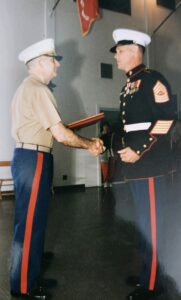
Mark’s platoon had four LAVs, each manned by a driver and a turret gunner. Mark was the third crewmember in his LAV and the platoon’s lieutenant would be added to one of the others except the platoon didn’t have a lieutenant yet. In fact, Mark served as the platoon commander until a lieutenant arrived three to five months later. Mark particularly enjoyed working with the new Marines out of boot camp because they were excited about being there and didn’t yet have any bad habits he’d have to teach them to break. They learned to how to fight the vehicles by convoying them to Fort Benning, Georgia, where they practiced tactics on the Army base’s diverse terrain. After six weeks at Fort Benning, Charlie Company returned to Camp Lejeune, ready to employ their new weapons’ capability.
Although it was exciting getting to work with the brand new LAVs, it did have one downside. The battalion’s commander treated them like new cars, insisting they be maintained in a spotless condition, both inside and out, even though they were intended to operate under combat conditions in the field and got dirty. This meant Mark and his platoon had to keep the LAVs in display-ready condition after every use. To ensure this was done, the battalion commander personally conducted inspections, always rolling under the vehicles on a dolly to make sure no dirt or mud lurked on the underside of the vehicles.
In 1986, Mark’s assignment with the 2nd LAV Battalion came to an end. For his follow-on tour, he accepted orders for recruiting duty, having arranged for an assignment in his hometown of Buffalo. First, he needed to complete twelve weeks of Recruiter School in San Diego. Then he moved his growing family to Buffalo where he started an amazing eleven-year recruiting run.
Mark began his assignment working at Recruiting Station Buffalo, where a Gunny he’d worked with during his I&I assignment at the Reserve Center asked for him by name. The Gunny made the right choice, as recruiting turned out to be in Mark’s blood. Deciding from the beginning to always be transparent and truthful with the recruits, their parents, and school officials, he quickly earned everyone’s trust and confidence.
Over the course of his eleven years recruiting in Buffalo, he worked at the main Recruiting Station in Buffalo, as well as the recruiting substations in Olean, Hamburg, Dunkirk, West Seneca, and Warren (Pennsylvania). During different periods over the eleven years, he served not only as a recruiter, but also as a recruiter instructor, the Non-Commissioned Officer in Charge (NCOIC) of the recruiting substations at Buffalo, Olean, and Hamburg, and the Operation Chief for the Buffalo Recruiting Station responsible for processing waivers and planning. He was so successful that he was meritoriously promoted to Gunny Sergeant and later promoted to Master Sergeant (E-8). He earned numerous accolades for meeting or exceeding recruiting mission goals, including NCOIC of the Year, Recruiter of the Month (several times), and Recruiting Substation of the Month (several times).
Although Mark made recruiting look easy, it was not. At times he was up at 4:00 a.m. to get applicants he recruited at Olean to the Buffalo MEPS by their 6:00 a.m. report time. Often, he worked until 8:00 p.m. or 9:00 p.m. meeting with recruits or their parents. He attended job fairs and endured his share of rude behavior, but he always kept his eye on mission accomplishment and gave recruiting his all. He somehow also managed to make time for his family, and Doreen gave birth to their third son, Matthew, in 1987.
Recruiting also proved stressful. Each month, Mark either had to meet personal recruiting quotas or office quotas, depending upon his position at the time. Meeting the quotas required more than just getting a recruit to sign the enlistment paperwork. To count, the prospect had to be a quality recruit, meaning they had to meet or exceed certain criteria and successfully graduate from boot camp. Recruit washouts anywhere along the way had to be made up for, and Mark was evaluated using an established formula on the quality of the recruits he enlisted.
Mark experienced this firsthand with the very first recruit he enlisted. After signing up the recruit and waiting for the recruit’s report date, Mark learned the recruit was burned to death in a car accident. Horrified by tragic death, Mark nonetheless had to work hard to find another recruit to replace the one who was killed because he did not make it successfully through the Delayed Entry Program.
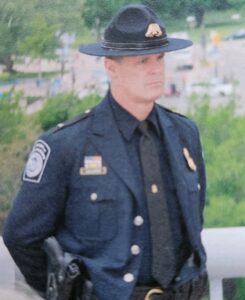
It was the positive stories, however, that kept Mark going. He loved helping young men and women who needed direction and discipline in their lives, or who came from terrible life situations, get on the right path. One prospect Mark recruited at Olean told Mark he had changed his mind and didn’t want to go through with his enlistment. Mark’s commanding officer thought it best to discharge him and find another prospect to make up for the loss. Mark chose instead to talk to the recruit to see what the problem was. He gave the recruit a few extra days to report for active duty, which was all the recruit needed. He went on to be the honor graduate from his boot camp class and qualified for duty at the U.S. Embassy in China.
After completing eleven years of recruiting in Buffalo, as well as twenty years, eight months, and eight days in the Marine Corps overall, Mark retired on June 1, 1997. He initially parleyed his recruiting skills into selling cars at a Ford dealership, but traded that job in for a short stint as the driver for a New York state assemblyman. Not liking that job at all, he applied for and was accepted by the Post Office, serving first as a journeyman filling in for people on vacation or sick leave, and later as a full-time worker at the Central Park Post Office.
Mark worked at the Post Office for three years until a surprise opportunity came his way. When he was still selling cars for the Ford dealership, one of his customers brought him an application for the Custom Service’s Veterans’ Recruitment Appointment Program. Mark applied but heard nothing further and assumed he did not get the job. Two years later when he was working for the Post Office, the Customs Service offered him a position. He accepted and began work on January 2, 2001. After attending Law Enforcement Training in Glencoe, Georgia, he worked for the Customs Service and its successor, U.S. Customs and Border Protection, at the Port of Buffalo for seventeen years. He finally retired with over forty years of distinguished federal service on June 1, 2018, although even then he continued to work parttime until March 2023 helping conduct interviews for new hires.
Today Mark lives with Doreen in Lancaster, New York, spending time with their three sons and five grandchildren and taking care of their two horses and their dog. As he looks back over his life and career, he is sure beyond a doubt that he owes any success he’s had in his life to the Marine Corps. His self-discipline, his leadership skills, and his ability to present information confidently to large groups of people all stem from his time as a Marine. In short, the Marine Corps made him the person he is today.
Voices to Veterans is proud to salute Master Sergeant Mark Zulawski, U.S. Marine Corps (Retired), for his forty years of dedicated federal service. Not only did he deploy whenever and wherever the Marine Corps needed him, but he also changed countless lives by opening the doors to leadership and discipline through service in the Marines. Not stopping there, he continued his life of service with the U.S. Postal Service and U.S. Customs and Border Protection. For all he has done, and for all the sacrifices he and his family have made, we wish him fair winds and following seas.
If you enjoyed Mark’s story, please sign up for the Voices to Veterans Spotlight monthly newsletter by clicking here. Once each month, you’ll receive a new written veteran’s story directly in your mailbox. Best of all, it’s free and you can unsubscribe at any time.


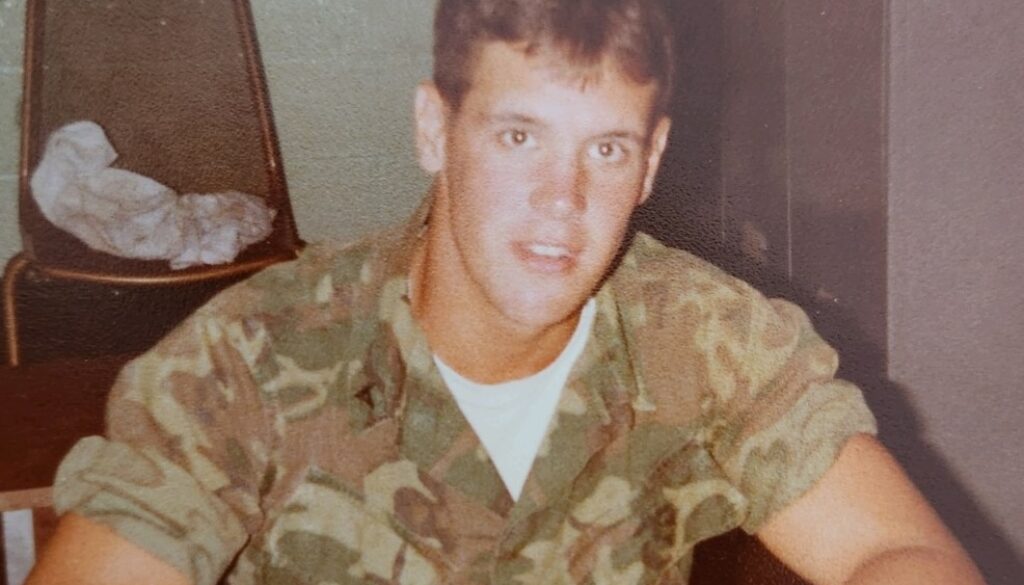

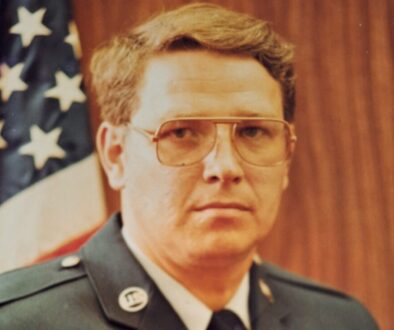

May 17, 2024 @ 5:40 PM
I thank you for posting Mark Zulawski’s story. It was enjoyable reading and brought back memories of my youth in Buffalo and Cheektowaga. I too went West Seneca East Highschool and played football with Mark (I was a junior during his senior year).
I also took a path in the military ending up with a 21 year career in the USAF. Retiring as a Master Sargent. My last 12 years I served as a crew member on Air Force One, serving under Presidents Reagan, Bush Sr. and Clinton. An incredible ride that I could have never imagined for a humble blue collar guy from Buffalo NY.
May 17, 2024 @ 9:30 PM
Michael, Thanks for reading Mark’s story and thanks for your service in the Air Force. It sounds like you had an amazing experience, as well. If you would allow me to work with you like I did with Mark to tell your story, I would love to do so. Just let me know.
V/r,
Dave Grogan